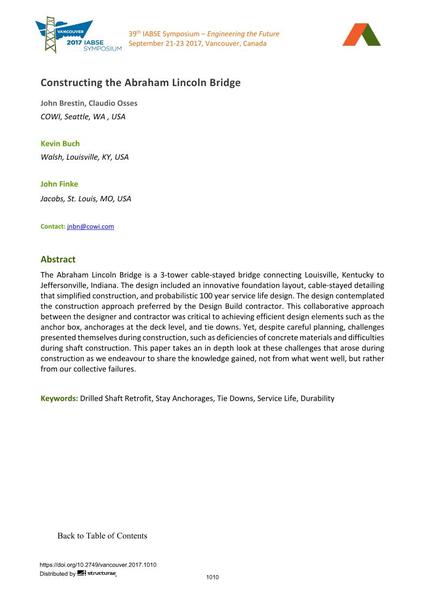Constructing the Abraham Lincoln Bridge

|
|
|||||||||||
Bibliographic Details
| Author(s): |
John Brestin
(COWI, Seattle, WA , USA)
Claudio Osses (COWI, Seattle, WA , USA) Kevin Buch (Walsh, Louisville, KY, USA) John Finke (Jacobs, St. Louis, MO, USA) |
||||
|---|---|---|---|---|---|
| Medium: | conference paper | ||||
| Language(s): | English | ||||
| Conference: | IABSE Symposium: Engineering the Future, Vancouver, Canada, 21-23 September 2017 | ||||
| Published in: | IABSE Symposium Vancouver 2017 | ||||
|
|||||
| Page(s): | 1010-1017 | ||||
| Total no. of pages: | 8 | ||||
| Year: | 2017 | ||||
| DOI: | 10.2749/vancouver.2017.1010 | ||||
| Abstract: |
The Abraham Lincoln Bridge is a 3-tower cable-stayed bridge connecting Louisville, Kentucky to Jeffersonville, Indiana. The design included an innovative foundation layout, cable-stayed detailing that simplified construction, and probabilistic 100 year service life design. The design contemplated the construction approach preferred by the Design Build contractor. This collaborative approach between the designer and contractor was critical to achieving efficient design elements such as the anchor box, anchorages at the deck level, and tie downs. Yet, despite careful planning, challenges presented themselves during construction, such as deficiencies of concrete materials and difficulties during shaft construction. This paper takes an in depth look at these challenges that arose during construction as we endeavour to share the knowledge gained, not from what went well, but rather from our collective failures. |
||||
| Keywords: |
durability service life Drilled Shaft Retrofit Stay Anchorages Tie Downs
|
||||
